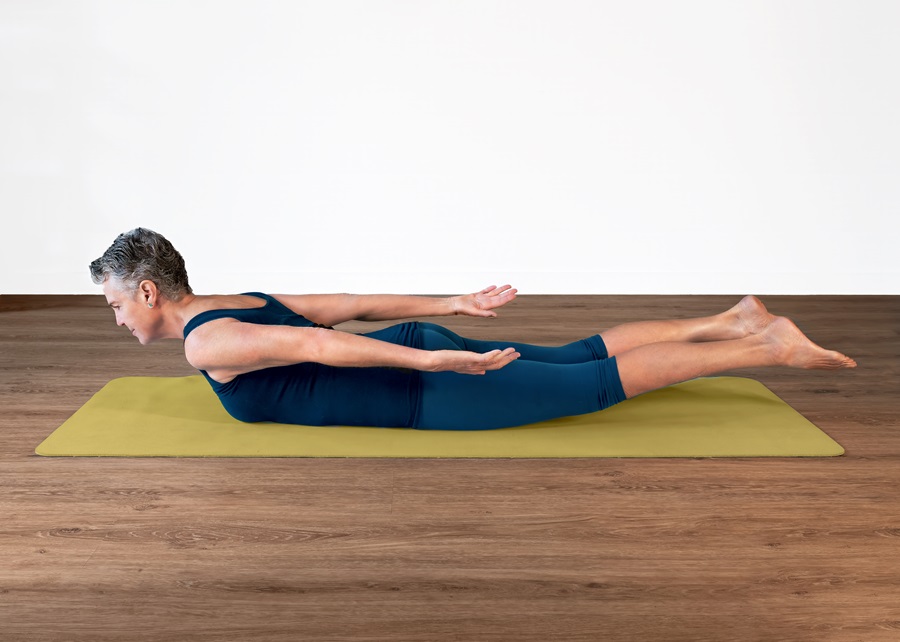For some people, the gatherings and celebrations of the winter holidays might be a welcome relief after an anxious election season. But for most, the winter holidays aren’t necessarily an antidote. They can offer their own special stress. In all, this is an important time to take care of ourselves.
I’ve been thinking especially about the benefits of poses that are what yogis call “heart openers.” The one I have in mind is called the Locust Pose or Salabhasana by most people, although my Kripalu training refers to it as the Boat Pose — a reminder that yoga isn’t precisely standardized.
In the Hindu and Buddhist traditions, the heart chakra is one of the body’s seven energy centers, and opening it is believed to help us feel more connected to one another and to nature.
You don’t have to adopt that philosophy to recognize that this pose opens the chest, where the heart lives, and it can be steadying, energizing, and uplifting. But there’s another way in which this pose, and really yoga in general, can help us: it is good for the brain.
I’ve been reading Dr. Sanjay Gupta’s book about brain health. Gupta is a neurosurgeon and journalist (he is CNN’s medical correspondent), and in his 2022 book Keep Sharp he writes that one of the five most important things to keep our minds “sharp and effortlessly productive” is simply to move. Moderate exercise, Gupta says, is the best kind for the brain. A brisk walk is better for your brain than a cardio workout, for example. So is yoga.
Two other top recommendations for brain health that Gupta talks about and that are very much part of a yoga practice are discovery and relaxation. He discusses the value of staying curious and doing things you haven’t done before. One of the things I love about yoga is that it gets us to move the body in new ways. Every time we practice it is a little different.
Like your body, the brain needs to rest. Relaxation comes with getting enough sleep. It also comes with taking breaks from screens, Gupta writes. Yoga can help with both of those. When you finish a yoga practice, you lie in Savasana, a relaxation pose, for several minutes to allow your body to absorb its benefits. And the Locust Pose involves a gentle backbend that feels especially good if you spend a lot of time slouched forward gazing at your screen.
Exploring the Locust Pose combines movement, discovery, and relaxation for the brain with the opening of the heart. This pose strengthens your back muscles, your glutes, and your hamstrings. It can help to counteract the effects of sitting and improve your posture.

To get into the pose, begin by lying on your mat on your belly and warming up with “windshield wipers”: Bend your knees and lift your feet, then drop them gently first to one side then the other, like windshield wipers. Place your forehead on the ground.
With arms at your sides, stretch your legs straight out behind you, ankles together. Press the tops of your feet and toes into the ground to engage your quadriceps. Rotate your inner thighs up. Then press your arms into the floor and lift your head, chest, and legs. (Two modifications to consider: If you need a lift, keep your hands on the ground by your chest and press into the floor to help you lift your chest. If lifting both legs feels too hard, try lifting one leg at a time.)
Next, let your arms float up, reaching back with your fingertips. Alternatively, you can try interlocking your hands behind you and drawing them down toward your feet as you lift your chest. This helps engage the muscles in your upper back. Either way, draw your shoulder blades down your back and lift your sternum. Keep the back of your neck long by slightly tucking your chin.
Keep the front and the back of the body long so as not to strain your lower back. Don’t focus on how high up you go but rather how much length and space you can create in your spine, sacrum, arms, and legs. Breathe and draw your chest forward as you reach your arms back. See how long you can get. Stay in the pose for several breaths.
To come out of the pose, release your arms, legs, and head to the floor. Turn your head to the side and rest. Give yourself some time to feel the imprint of the pose on your body. May it take you toward the holidays with an open heart and a better brain.
